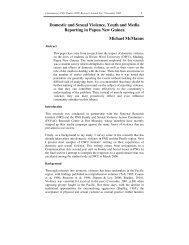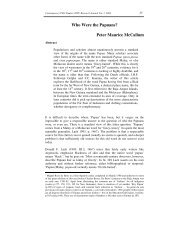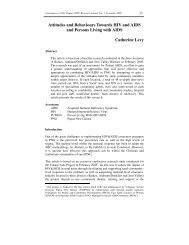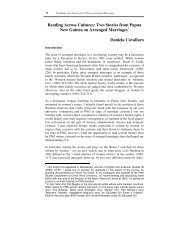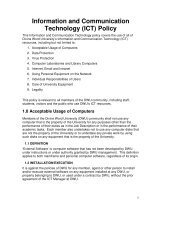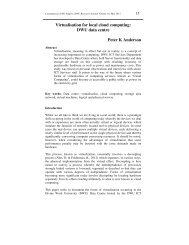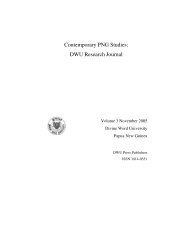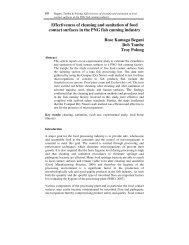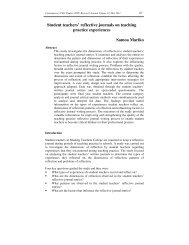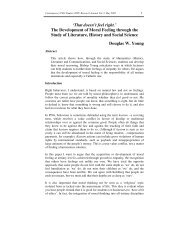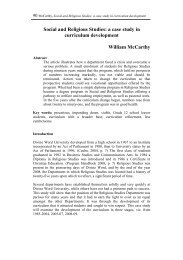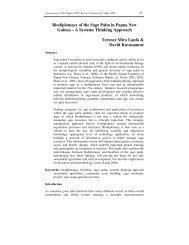A short study of Melpa rehistory - Divine Word University
A short study of Melpa rehistory - Divine Word University
A short study of Melpa rehistory - Divine Word University
- No tags were found...
Create successful ePaper yourself
Turn your PDF publications into a flip-book with our unique Google optimized e-Paper software.
8Howley, A Short Study <strong>of</strong> <strong>Melpa</strong> P<strong>rehistory</strong>cult is, in fact, one way in which a big-man demonstrates his successfulentrepreneurship (Strathern, 1970, p.572).Big-man, control <strong>of</strong> shellsMarine shells worked as ornaments have been reported back to 9000 BP inexcavated rock-shelters in the Papua New Guinea Highlands (Golson &Gardner, 1990, p.408). Twelve species <strong>of</strong> shell were common but it was thegold lip pearl shell which had by far the greatest value for barter. The supplywas unreliable and subject to long term interruptions. As already mentioned, itwas the prerogative <strong>of</strong> the big-men to control the supplies <strong>of</strong> shells, axes,plumes and other goods, and they made every effort to protect their privileges.Shells were by far the most important as they were the essential token inmaking moka.Big-man, control <strong>of</strong> mokaWith the coming <strong>of</strong> the sweet potato anyone could grow sweet potato and raisepigs and so theoretically anyone could be a big-man. Thus it was necessary forthe powerful leaders who managed the politics <strong>of</strong> the clan to find means todemonstrate their superiority (Strathern, 1979, p.533).The moka had its origins in the reciprocal gift-giving process mentioned as apart <strong>of</strong> the social contract. Any gift required a return <strong>of</strong> a gift <strong>of</strong> equal orgreater value. Gifts <strong>of</strong> food could be repaid much later in services such ashouse building or support in some other venture. This fitted neatly into theexciting ceremonies and exchanges <strong>of</strong> the moka.‘Making moka’ entails repaying a gift-debt, not just with an equivalent return,but with a value culturally defined as more than what the initial gift was worth.<strong>Melpa</strong> construe moka exchanges to balance in the long term; they are in whatStrathern terms an ‘alternating disequilibrium’ (Ledeman, 1990, p.8). Themoka, like ‘the Tee (in Enga), flowed on a path no bigger than a single strand<strong>of</strong> a spider's web; all care must be taken not to break it’ (Wisner, 1998, p.163).The ‘moka’ was an artificial and symbolic exchange <strong>of</strong> shells and othervaluables which depended on an exchange for other valuables, especially pigs,and in the final analysis on pig production and the ability <strong>of</strong> men to bargain intheir own favour. In actual shell-moka the starting mechanism was always asolicitory gift which included a pig, as well as two shells, in return for whicheight or ten shells would be expected in moka. Pigs had to be reared at home,and the major input <strong>of</strong> work here came from women (Strathern, 1975, p.535-536).Ordinary people became involved by working directly for the big-men in thehope <strong>of</strong> returns <strong>of</strong> wealth in the form <strong>of</strong> pearl shells for assistance in brideprice. The big-men did not necessarily ‘own the wealth’ so much as ‘control’ it.This was the essential skill <strong>of</strong> the <strong>Melpa</strong> big-man. It was a competition betweenpartners and groups to give back more than one has received. To put it in its



